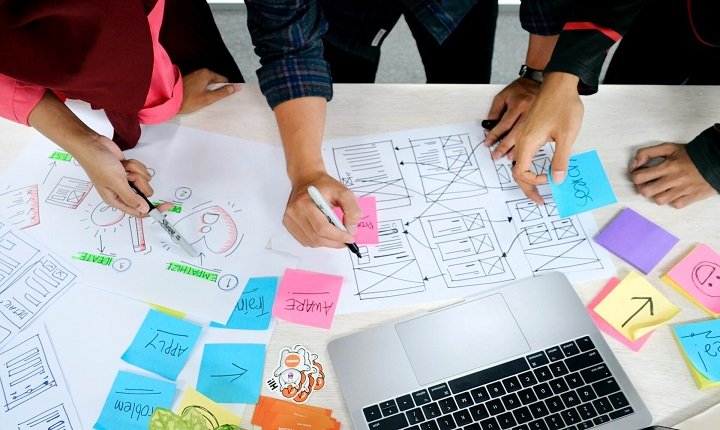Best practices for collaborative programming collaborative programming is getting to be more basic in today’s program improvement scene. Whether you’re working in a startup, at a tech mammoth, or taking part in an open-source project, collaborating with others on code is a vital ability. But compelling collaboration requires more than just different individuals working on the same codebase. It requires clear communication, structure, and best hones to guarantee the victory of the project.
In this web journal, we will investigate the best hones for collaborative programming that can offer assistance you and your group make superior code, progress efficiency, and make the general involvement agreeable and efficient.
What are the best practices for collaborative programming?
Collaborative programming, also known as combine programming or gather coding, includes two or more engineers working together to total a venture. In step of coding in separation, group individuals share thoughts, compose code, and survey each other’s work in genuine time. This strategy is as often as possible utilized in dexterous situations, but the concept can be connected to any advancement workflow.
Collaborative programming makes a difference. Groups create higher-quality code faster, decrease mistakes, and guarantee that everybody included has a profound understanding of the codebase.
Why is collaborative programming important?
Collaborative programming isn’t fair—almost getting the work done faster—it’s approximately moving forward the in general quality of the code. When numerous individuals collaborate on a venture, they bring distinctive encounters and viewpoints to the table. This differences of thought regularly comes about in more strong arrangements to problems.
Benefits include:
- Improved Code Quality: With more individuals checking on and contributing to the code, the chance of mistakes diminishes. Distinctive eyes can spot diverse issues that might be missed by a single developer.
- Enhanced Learning: Junior designers can learn from senior engineers, and indeed, experienced coders can choose up modern methods from others.
- Better Problem-Solving: With different minds working together, challenges are handled more effectively and creatively.
- Reduced Information Silos: When one individual codes alone, as if they have a profound understanding of the code. Collaborative programming guarantees that information is shared, making the group more versatile to startling unlucky deficiencies or departures.
Best Hones for Collaborative Programming
1. Utilize Form Control Effectively
One of the most basic instruments for collaborative programming is form control program like Git. Adaptation control permits groups to work on diverse parts of a project at the same time without overwriting each other’s changes. Utilizing branches and drag demands, engineers can separate their work and, as it were, consolidate it into the primary department when it’s total and reviewed.
Here are a few tips for viable adaptation control:
- Create significant commit messages: Make beyond any doubt your commit messages clearly depict the changes you’ve made.
- Use branches admirably: Continuously make a modern department for each highlight or bug settle. This keeps the primary department clean and permits for simpler rollbacks if something goes wrong.
- Review code some time recently blending: Don’t consolidate code into the fundamental department without an appropriate code audit. This makes a difference, guarantees the quality of the codebase and permits group individuals to grant feedback.
2. Communication is Key
When collaborating on code, communication gets to be the spine of the extend. Normal and clear communication guarantees that everybody is on the same page and makes a difference; maintain a strategic distance from errors that may lead to squandered time or buggy code.
- Daily stand-ups or check-ins: Utilize brief, day-by-day gatherings (either in individual or for all intents and purposes) to talk about advance, barricades, and what everybody will be working on. These offer assistance in keeping the group adjusted and focused.
- Document everything: Keep records of choices made, coding rules, and major changes. Devices like Conversion or Idea are fabulous for recording critical viewpoints of a project.
- Use communication stages: Instruments like Slack or Microsoft Groups give extraordinary ways to communicate in genuine time. Channels committed to particular points (e.g., backend, frontend, plan) can offer assistance and keep discussions organized.
3. Utilize Coding Measures and Guidelines of Best practices for collaborative programming
Establishing a set of coding guidelines is a must in collaborative programming. These rules guarantee that everybody composes code in a steady way, making the codebase less demanding to study, get, and maintain.
- Set clear rules: Choose on the programming fashion (tabs vs. spaces, naming traditions, space, etc.) some time recently beginning the extend. Everybody ought to follow to the same rules.
- Linting apparatuses: Utilize linters like ESLint or Pylint to consequently uphold coding measures. These instruments offer assistance in capturing potential issues early on.
- Consistent naming traditions: Adhere to a steady naming procedure for factors, capacities, and record names over the codebase. This consistency will make it simpler for all group individuals to take after the stream of the project.
4. Hone Combine Programming
One compelling strategy of collaborative programming is combine programming. Where two engineers work together on a single assignment. Ordinarily, one individual composes the code (the “driver”), whereas the other audits the code in genuine time (the “navigator”).
- Rotate parts: To guarantee that both members remain locked in, frequently switch parts between the driver and navigator.
- Discuss arrangements some time recently coding: Some time recently you began coding, took time to talk about the assignment and chose an arrangement. This way, you dodge mistaken assumptions and squandered effort.
- Use farther apparatuses when required: With inaccessible work on the rise, instruments like Visual Studio Code Live Share and Tuple permit designers to match program indeed when they’re miles apart.
5. Execute Code Reviews
Code audits are an indispensable portion of collaborative programming. They guarantee that all code is checked for potential bugs, irregularities, or zones for improvement.
- Be helpful in input: The objective of a code audit is to progress the code, not criticize the coder. Give criticism in a way that empowers learning and growth.
- Focus on the code, not the individual: Keep the survey proficient and centered on the code’s quality. Maintain a strategic distance from individual comments and center on progressing the project.
- Use drag demands: Drag demands are an awesome way to propose changes and permit group individuals to survey and examine the code some time recently it’s combined into the fundamental branch.
6. Cultivate a Collaborative Environment
Collaboration is not almost composing code together—it’s approximately making an environment where everybody feels comfortable sharing their thoughts and contributing to the project.
- Encourage open communication: Make beyond any doubt that everybody feels comfortable talking up and sharing their considerations, whether it’s amid a code audit or a group meeting.
- Celebrate victories: Take time to recognize when things go well. This boosts assurance and cultivates a sense of group spirit.
- Learn from mistakes: When things go off-base, don’t center on fault. Instep, treat it as a learning opportunity for the team.
7. Utilize Extend Administration Tools of Best practices for collaborative programming
To keep the extend on track, utilize venture administration apparatuses like Jira, Trello, or Asana to allot assignments, track advance, and oversee deadlines.
- Create clear assignments: Break bigger assignments into littler, reasonable chunks. This makes it simpler for the group to work on diverse parts of the venture simultaneously.
- Set reasonable due dates: Make beyond any doubt that due dates are achievable and that the group has sufficient time to total each errand without feeling overwhelmed.
Conclusion
Collaborative programming can be a game changer when it comes to composing high-quality code effectively. By taking after best hones like utilizing adaptation control, setting clear coding measures, and keeping up open communication, groups can work together easily and effectively.
Whether you’re working with a little group on a startup extend or collaborating with hundreds of designers on an open-source activity,. The right instruments, hones, and mentality can make all the difference.
For more data on progressing your team’s coding hones, check out this point-by-point direct on viable collaboration in computer program improvement.
FAQs:
7. What are the benefits of collaborative programming?
Some of the major benefits include:
- Improved code quality due to multiple reviews and shared knowledge.
- Enhanced learning opportunities, as developers can learn from each other.
- Faster problem-solving because more people are contributing ideas and solutions.
- Reduced knowledge silos ensure multiple people are familiar with all parts of the codebase.
8. What are some common challenges in best practices for collaborative programming?
Some common challenges include:
- Communication barriers, especially in remote teams.
- Differences in coding styles, which can lead to confusion.
- Merge conflicts when working with version control systems.
- Over-reliance on one person, which can happen if the team isn’t collaborating equally.
9. How do you maintain consistency in a collaborative codebase?
To maintain consistency, establish coding standards that everyone on the team follows. Use linting tools to automatically enforce these standards, and ensure that all team members are aligned on practices such as naming conventions, formatting, and structure.
10. What’s the difference between collaborative programming and traditional coding?
In traditional coding, each developer works independently on their assigned tasks and only integrates their code at the end. Collaborative programming, on the other hand, emphasizes working together throughout the process, sharing ideas, and continuously reviewing each other’s code for better quality.






